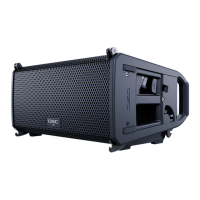42
Daisy-Chaining with Balanced XLR Jumper Cables
1. Connect the audio source (mixer, musical instruments, audio player, etc.) to the LINE IN XLR connector (6) on the rear panel.
2. If additional units are daisy-chained in the array, connect the audio loop-thru jumper cable (not supplied) from the LINE OUT XLR
connector to the LINE IN XLR connector on the next loudspeaker.
3. Continue this process until all loudspeakers in the array are connected using balanced XLR cables.
Network Connections
The dual network connectors also support daisy-chaining multiple loudspeakers in an array. Unlike the powerCON and XLR
connectors, which have dedicated input and throughput connectors, the network ports are identical switched-ethernet ports, which
means either can be used as an input or as a network hop to the next unit in the array.
The network ports can accept either a rugged etherCON connector or a standard RJ45 connector; however, it is always recommended
to use etherCON type connectors, rather than conventional RJ45 connectors, as the mechanical robustness and EMC performance is
superior.
Each loudspeaker includes two IP addresses, one dedicated to “control” and one dedicated to “Dante audio-over-IP.” However, both
control and Dante data traffic are carried over a single CAT5/6 cable into a single RJ45 port.
Daisy-Chaining with Network Jumper Cables
There are two common methods for connecting network devices:
a. Star Topology: With the star topology method, each device has its own port on an ethernet switch. This is the most robust method,
but it requires a cable home run from each device back to the ethernet switch, which is fine for permanent installations but
challenging for temporary deployments.
b. Daisy Chain: The daisy-chain method requires dual switched ports on each device, as found on the LA108/LA112 loudspeakers.
While daisy-chaining is much easier to deploy, it should be noted that each “hop” incurs a latency penalty, measured in micro-
seconds that quickly add up. Therefore, a pre-determined latency is applied to each Dante-receiving device to account for switch
hops, eliminating the risk of dropped packets and resulting audio glitches.
The Dante latency settings are based on worst-case latency assumptions and are therefore quite conservative. The LA108/LA112
loudspeakers default to 1 ms, which will accommodate up to 10 switch hops.
As a reference point, a Dante mixer connected through an ethernet switch to a 6-box daisy-chained array of LA108 or LA112
loudspeakers is the equivalent of 6 switch hops.
If 5 switch hops or less are used, there is the potential to adjust the latency down from 1 ms to 0.5 ms using the Dante Controller
software. Please refer to Audinate for more information on Dante Controllers.
For ethernet daisy-chaining, the optional LA-KIT-J or LA-KIT-J-NA jumper kit mentioned above is needed (refer to the Accessories
section for more information).

